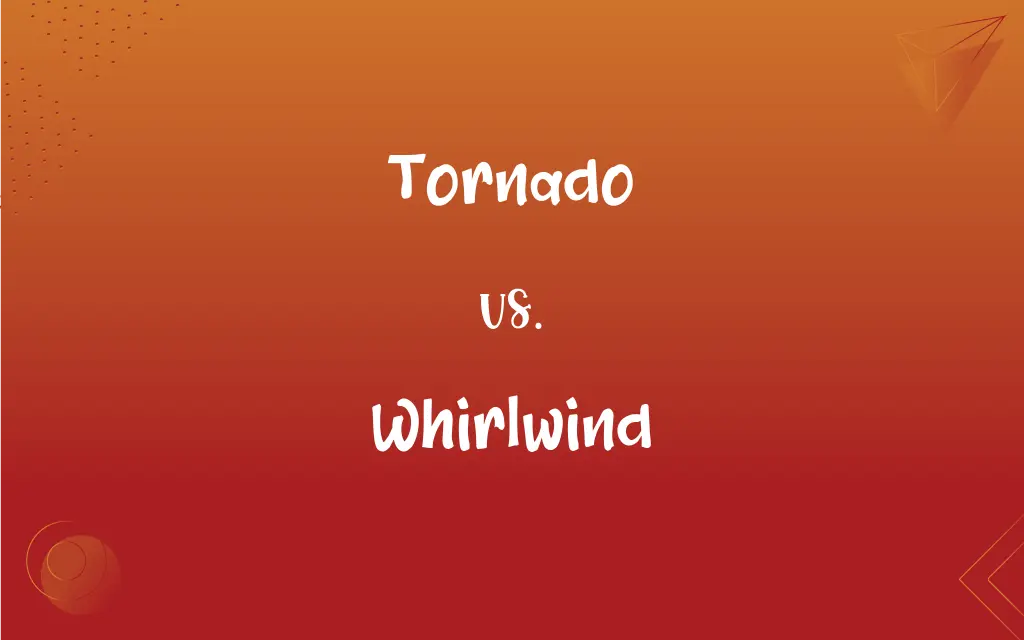Tornado vs. Whirlwind: What's the Difference?
Edited by Harlon Moss || By Janet White || Updated on October 2, 2023
A tornado is a violent rotating column of air extending from a thunderstorm to the ground, while a whirlwind is a rotating column of air, usually smaller and less destructive, that can occur under various weather conditions.

Key Differences
Tornado and whirlwind, both describe atmospheric phenomena involving rotating columns of air, but they are distinct in their nature, size, and impact. A tornado is characterized by its violent and destructive nature, typically extending from the base of a thunderstorm to the ground, associated with severe weather conditions. Tornadoes are capable of causing extensive damage due to high winds, often exceeding 200 miles per hour. In contrast, a whirlwind is a more generic term describing any rotating column of air, regardless of its size and intensity, which can occur under a variety of weather conditions, not exclusively severe ones, and is typically less destructive.
While tornadoes are infamous for their potential to cause devastation, being meticulously studied and classified based on their intensity and the damage they can inflict, whirlwinds encompass a broader range of vortices, including dust devils and smaller vortexes which may not cause significant harm. Tornadoes are associated with specific meteorological setups, usually forming in severe thunderstorms where there are substantial updrafts and variations in wind speed and direction with height, which aid in the development of rotation. Whirlwinds, conversely, can form even in relatively benign weather conditions and may consist of merely visible columns of dust or debris with limited rotational velocity.
The detection and study of tornadoes are integral to meteorology due to their destructive capacity, and extensive warning systems and research are dedicated to understanding and predicting their formation and path. On the other hand, whirlwinds, being less intense and more diverse in their nature and origin, do not command the same level of scientific attention or public concern, with many whirlwinds going unnoticed or unreported due to their transient and often harmless nature.
In common parlance, the term tornado is almost synonymous with destruction and is specifically used to describe those rotating columns of air which have a destructive and impactful presence, possessing defined characteristics and classifications. The term whirlwind, meanwhile, is used more broadly and can refer to any rotating column of air, be it a gentle and small vortex or a larger and more noticeable one, reflecting its more general and encompassing nature.
Though both tornado and whirlwind represent atmospheric phenomena involving rotation, the notable differences in their intensity, impact, formation conditions, and the level of concern and study they attract underscore the importance of distinguishing between these two terms.
ADVERTISEMENT
Comparison Chart
Intensity and Impact
Violent and destructive, associated with severe weather conditions
Generally less intense and destructive, can be benign
Formation Conditions
Typically form in severe thunderstorms
Can form under various weather conditions
Size and Scope
Usually larger and more defined
Can be small and transient, more varied in size and duration
Scientific Attention
Extensively studied due to potential for harm
Less studied, often goes unnoticed or unreported
Terminology
Specific term with defined characteristics and classifications
General term encompassing a variety of rotating air columns
ADVERTISEMENT
Tornado and Whirlwind Definitions
Tornado
A violently rotating column of air extending from a thunderstorm to the ground.
The tornado uprooted trees and destroyed buildings.
Whirlwind
A small rotating column of air, usually not as destructive as a tornado.
The whirlwind lifted the leaves into the air.
Tornado
A meteorological phenomenon that can cause extensive damage.
Meteorologists are studying the causes and behaviors of tornadoes to improve prediction models.
Whirlwind
A generic term for any rotating wind, can be harmless.
The children chased the small whirlwind around the yard.
Tornado
A natural disaster associated with thunderstorms and severe weather conditions.
The community took shelter as the tornado approached.
Whirlwind
A rapidly moving or changing phenomenon.
The project was completed in a whirlwind of activity.
Tornado
A funnel-shaped cloud causing high winds and destruction.
The tornado left a path of destruction several miles wide.
Whirlwind
Can be a visible column of rotating air like a dust devil.
The whirlwind crossed the open field, swirling dirt as it moved.
Tornado
A mobile, destructive vortex of violently rotating winds.
A tornado swept through the town, leaving devastation in its wake.
Whirlwind
A rapidly rotating, generally vertical column of air, such as a tornado, dust devil, or waterspout.
Tornado
A violently rotating column of air extending from a cumulonimbus cloud to the ground, ranging in width from a few meters to more than a kilometer, with destructive winds up to 510 kilometers (316 miles) per hour or higher. Tornadoes are typically associated with a funnel cloud pendant from a storm's wall cloud, often extending to the bottom of the tornado.
Whirlwind
A tumultuous, confused rush.
Tornado
A violent thunderstorm in western Africa or nearby Atlantic waters.
Whirlwind
A destructive force or thing.
Tornado
A whirlwind or hurricane.
Whirlwind
Tumultuous or rapid
A whirlwind political campaign.
Tornado
(meteorology) A violent windstorm characterized by a mobile, twisting, funnel-shaped cloud.
A tornado is a rotating column of air.
Whirlwind
A violent windstorm of limited extent, as the tornado, characterized by an inward spiral motion of the air with an upward current in the center; a vortex of air. It usually has a rapid progressive motion.
Tornado
A violent whirling wind; specifically (Meteorol.), a tempest distinguished by a rapid whirling and slow progressive motion, usually accompaned with severe thunder, lightning, and torrents of rain, and commonly of short duration and small breadth; a small cyclone.
Whirlwind
(figuratively) A person or body of objects or events sweeping violently onward.
Once he got that new scooter he turned into a whirlwind and damaged all the flowers.
The weeks leading up to the convention were a whirlwind of preparation and hurried activity.
Tornado
A localized and violently destructive windstorm occurring over land characterized by a funnel-shaped cloud extending toward the ground
Whirlwind
Rapid and minimal: a whirlwind tour, a whirlwind romance.
Tornado
A purified and potent form of cocaine that is smoked rather than snorted
Whirlwind
A violent windstorm of limited extent, as the tornado, characterized by an inward spiral motion of the air with an upward current in the center; a vortex of air. It usually has a rapid progressive motion.
The swift dark whirlwind that uproots the woods.And drowns the villages.
Whirlwind
Fig.: A body of objects sweeping violently onward.
Whirlwind
A more or less vertical column of air whirling around itself as it moves over the surface of the Earth
Whirlwind
A vortex of wind that can form under various conditions.
The whirlwind spun dust and debris into the air.
FAQs
Is a tornado associated with severe weather conditions?
Yes, tornadoes typically form in severe thunderstorms with substantial updrafts and wind variations.
Is a tornado always destructive?
While not always, tornadoes are often highly destructive due to their intense rotational winds.
Can a whirlwind form in benign weather conditions?
Yes, whirlwinds can form under a variety of weather conditions, including benign ones.
Is the term whirlwind more general than tornado?
Yes, whirlwind is a more general term, encompassing a variety of rotating columns of air.
Can a whirlwind be harmless?
Yes, many whirlwinds are small, transient, and largely harmless.
Are tornadoes studied more extensively than whirlwinds?
Due to their destructive potential, tornadoes do receive more extensive study and attention compared to most whirlwinds.
Can the term tornado refer to a specific type of rotating column of air?
Yes, the term tornado specifically refers to a violently rotating column of air extending from a thunderstorm to the ground.
Are all whirlwinds visible?
No, not all whirlwinds are visible, but they can lift dust and debris, making them apparent.
Can tornadoes occur over water?
Yes, when tornadoes occur over water, they are referred to as waterspouts.
Are tornado warning systems important?
Absolutely, tornado warning systems are crucial to provide advanced notice to areas in the path of a tornado.
Does the term whirlwind include dust devils?
Yes, dust devils are a type of whirlwind, characterized by a small, rapidly rotating column of air.
Do tornadoes have a specific classification system?
Yes, tornadoes are classified based on their intensity and the damage they cause, using the Enhanced Fujita scale.
Can whirlwinds be created artificially?
Yes, whirlwinds can be artificially created in controlled environments for study purposes.
Are whirlwinds always associated with weather systems?
Whirlwinds can form under various weather conditions but are not always associated with larger weather systems.
Can whirlwinds occur indoors?
It’s unusual, but small whirlwinds can occur in large indoor spaces under specific conditions.
How fast can tornadoes travel?
Tornadoes can travel at varying speeds, with the fastest recorded moving at around 70 miles per hour.
Do tornadoes have a characteristic shape?
Tornadoes are often characterized by their funnel shape, but they can vary in appearance.
Can whirlwinds have different shapes?
Whirlwinds can appear in various forms and sizes, and they don’t have a characteristic shape like tornadoes.
Are tornadoes more likely in certain geographical areas?
Yes, tornadoes are more likely in areas known as Tornado Alley in the United States due to favorable conditions.
Do whirlwinds last for a long duration?
Most whirlwinds are transient and short-lived, but their duration can vary.
About Author
Written by
Janet WhiteJanet White has been an esteemed writer and blogger for Difference Wiki. Holding a Master's degree in Science and Medical Journalism from the prestigious Boston University, she has consistently demonstrated her expertise and passion for her field. When she's not immersed in her work, Janet relishes her time exercising, delving into a good book, and cherishing moments with friends and family.
Edited by
Harlon MossHarlon is a seasoned quality moderator and accomplished content writer for Difference Wiki. An alumnus of the prestigious University of California, he earned his degree in Computer Science. Leveraging his academic background, Harlon brings a meticulous and informed perspective to his work, ensuring content accuracy and excellence.
































































